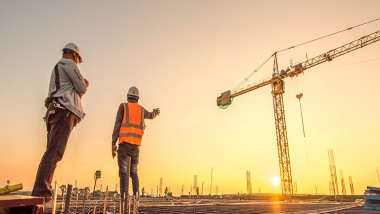Infrastructure: the Rise of an Asset Class
Key Takeaways:
- Infrastructure assets have more than quadrupled over the last decade and are expected to keep growing at the same speed over the coming years. Three trends will drive this: environmental transition, technological transition and social transition.
- The increasing sophistication of investors is forcing asset managers to evolve, to become more efficient and stand out by maximizing their alpha. They must acquire well, realize value creation and grow assets over the long term.
- Infrastructure is key to the fabric of communities, providing vital amenities key to daily life such as clean water, safe and efficient transportation, communication, education and health. So the industry must focus more on stakeholder engagement.
The asset class has more than quadrupled over the last decade and is expected to keep growing at the same speed over the next few years, thanks to the amazing traction from investors. The enhanced appetite for infrastructure emerged from the aftermath of the GFC, as institutional investors looked for alternatives to fixed income investment in an environment of low interest rates. The Covid crisis is very likely to increase investors’ appetite for infrastructure further as the asset class demonstrates its resilience.
What surprises me most is the recent acceleration in its growth: infrastructure now represents about 4% on average of the portfolios of pension funds, insurance companies, funds of funds, family offices, and wealth management institutions.
The pool of investors has become more diversified and sophisticated, with an increasing number of investors looking for direct co-investment opportunities and becoming more selective in their choice of asset managers. And the number of infrastructure asset managers has increased dramatically in parallel with the growth of the asset class. However, there is notable concentration in fewer and fewer hands: in 2019, of the $98 billion raised, 69% was raised by just 10 asset managers.
This massive inflow of money, nevertheless, is not struggling to find opportunities to invest as unlike other asset classes, where a flood of capital has proved challenging for fund managers to absorb, infrastructure still has plenty of levers left to pull. The EU estimates that it needs €270 billion of investment a year through 2030 to maintain its competitiveness.
Is the asset class becoming more PE-like?
Infrastructure differs from private equity in terms of the investment approach and underlying assets. When investing in core infrastructure, investors are seeking long-term, predictable cash flows that provide stable returns. Infrastructure assets display resilience – quasi-monopoly, regulated assets, long-term contracted cash flows – which justify a difference in treatment in capital allocation by the insurance regulator in Europe.
Infrastructure and private equity nevertheless share several key features:
- good origination capacity;
- requirement for good structuring;
- buildout, de-risk and drive value focus;
- capacity to develop investments by building platforms around them to grow them into real leaders in their sector.
The asset class is maturing with segmented strategies and specialization of asset managers, addressing both market potential deployment and investors’ appetite for diversification. Core, Core+, and Value-add have emerged in tandem with global strategies with specific sector focus or geographies. Godzilla Funds of $20 billion have emerged alongside focused, niche strategies managing €300 million or less. Funds of funds also have been created for secondary opportunities. Mid-market remains a segment with lots of opportunities. The average size of asset managers and deals has progressively increased, incentivizing many of them to exit the mid-market and leaving more opportunities for mid-market specialists.
How do you think newer infrastructure sectors will perform in a downturn?
Newer infrastructure sectors emerge progressively in parallel with the evolution of the needs of communities and provided that these new infrastructures continue to display the very features of robustness and resilience that you can find in traditional infrastructures, they are likely to perform equally well. Digital infrastructure investment, for example, did not exist 15 years ago, and was only included in the portfolios of a couple of infrastructure managers as recently as 10 years ago. Today it is the rising star of the sector. The main reason is that digital infrastructure has become essential to the development of communities and is now as essentially as a utility. Interstingly enough we are discovering now that it is not onlyt resilient to crises, but acn also prove strong opportunities of growth.
How has infrastructure changed in response to the growing sophistication of investors and the complexity of infrastructure assets?
The increasing sophistication of investors is forcing asset managers to evolve, to become more efficient and stand out from the crowd by maximizing their alpha. In short, they must acquire well, realize value creation and grow the business over the long term. Investors require higher standards in terms of the frequency of reports, the level of data they require, ESG performance, carbon footprints, fast and efficient deployment of funds, levels of yield and IRR, and risk management. Some investors are also starting to invest directly by creating their own infrastructure teams. This is an opportunity for us, as asset managers, to prove that we can still bring them value through complementary investment opportunities, fund structuring and asset management skills. In downturn scenarios, it is also an opportunity to remind investors that infrastructure performs well when managed by specialists of the sector as it requires adequate expertise, due diligence skills, structuring and active asset management capacity done by infrastructure experts to withstand headwinds.
What are the macro trends shaping the evolution of infrastructure?
There are three main trends: environmental transition, technological transition and social transition. In terms of environmental transition, with the rise of climate concerns and growing awareness of biodiversity and air quality issues, investor expectations have changed significantly. For the first time, the Global Risk Report 2020 by the World Economic Forum stated that the top five global risks are all environment related. People now expect more eco-friendly public policies, an energy mix that promotes the use of renewable energies, and energy efficiencies. On the technological transition, the industry is clearly being influenced by data, AI and IoT, alongside the emergence of new business models, which are focused around platforms. And on the social transition, two-thirds of the world’s population will live in cities by 2050. There will be an increase in inequality as the middle-class declines. Also, the population is ageing, while young people are increasingly hyper-connected. These three factors are likely to be accelerated by the current pandemic, which will serve as a catalyst for new business models.
How do you view technology disruption?
Technological obsolescence or factors that could impair the usage of our assets are key risks. In carrying out our due diligence, we assess the capacity of our investments to adapt to new technology and their capacity to provide an essential service to communities through technology.
Obstacles to investment can arise from policies or political barriers, or lack of stakeholder support. How important is community and stakeholder engagement?
Infrastructure is key to the fabric of communities, providing vital amenities such as clean water, safe and efficient transportation, communication, education, health and services that underpin economic development. The industry has evolved and is increasingly taking into consideration stakeholder engagement, but this has not yet become a mainstream approach. Having a stakeholder approach, however, is compulsory because of the scale and breath of infrastructure, how many people it affects and how it impacts their daily lives.
What will be the impact of a more protectionist economic environment?
A more protectionist macroeconomic environment may impact supply chains of infrastructure companies in a detrimental way by forcing them to refocus on local suppliers. It is also likely to adversely impact investors by limiting their capacity to invest in some geographies, or in sectors that are considered strategic by some countries. Regulatory risk will be a bigger part of due diligence as investors assess the likelihood of rule changes that could impact the development and performance of infrastructure projects.
What do you expect from infrastructure over the next 10 years?
We expect the asset class to continue to grow further and mature. Infrastructure constitutes the building blocks of our society, designed to serve communities for several generations. Beyond its capacity to generate resilient cash flows, infrastructure investment also provides us with a unique opportunity to make a positive impact on the environment and on society. So it is likely to continue to generate very significant traction from investors.
Vauban Infrastructure Partners
Affiliate of Natixis Investment Managers
Société en Commandite par Actions – Limited Partnership by shares
Share capital : €10 076 680.20
Regulated by the Autorité des Marchés Financiers (AMF) under n° GP – 19000044
RCS Paris 833 488 778
115 Rue Montmartre
75002 Paris
www.vauban-ip.com
Natixis Investment Managers
RCS Paris 453 952 681
Share Capital: €178 251 690
43 avenue Pierre Mendès France
75013 Paris
www.im.natixis.com
This communication is for information only and is intended for investment service providers or other Professional Clients. The analyses and opinions referenced herein represent the subjective views of the author as referenced unless stated otherwise and are subject to change. There can be no assurance that developments will transpire as may be forecasted in this material.
Copyright © 2021 Natixis Investment Managers S.A. – All rights reserved





 The Era of Infrastructure 4.0
The Era of Infrastructure 4.0
 Infrastructure 4.0 – Are You Ready?
Infrastructure 4.0 – Are You Ready?
 Infrastructure: Let’s Get Personal
Infrastructure: Let’s Get Personal
 Vauban’s Core Infrastructure Financing
Vauban’s Core Infrastructure Financing